Learn how to make butter at home in 5 different ways with just one ingredient and a few simple steps! This homemade butter recipe provides rich, creamy, and absolutely delicious results! Most often made with just heavy cream, butter can be salted or unsalted, and ready to use in all your favorite recipes or spread all over freshly baked bread, in just a matter of minutes!

Jump to:
- What is butter
- How was butter originally made
- What is homemade butter made of
- How to make butter from cream
- 1. Make butter in a jar
- 2. Make butter in a mixer
- 3. Make butter by blender
- 4. Make butter by hand
- How to make butter from milk (without heavy cream)
- How to store butter
- Expert tips for making butter at home
- Homemade butter - Flavoring tips
- Homemade Butter Recipe FAQS
- Conclusions
- My favorite baking recipes made with delicious butter
- How to make butter at home
What is butter
Most of us already know what butter is! It's that addictively good rich and creamy stuff that you use on bread, to make French sauces, add to potatoes, and of course, often used in baking!
With its delicious flavor, it's no surprise how popular and common butter is used as a recipe ingredient, condiment, and spread. It makes baked goods rich with flavor, is the perfect fat for sauteing, and when melted or caramelized has a lovely nutty flavor.
But when it comes to food science, what is butter? In simple terms, butter is a dairy product made from milk that consists of butterfat, milk proteins, and water. It's made by churning cream or milk to separate the fat until it becomes a semi-solid emulsion.
Butter can be salted or unsalted and is typically made from cow's milk, but can also be made from the milk of sheep, goats, buffalo, and even yaks. Most butter is about 80% fat (or 82% - the so-called European-style butter) and stays solid at room temperature; however, melts easily when heated.
How was butter originally made
Back in the day, from the Middle Ages all the way up until the Industrial Revolution, the butter churning process was done by hand. They put the cream into a barrel and then moved a plunger up and down to churn it for hours and hours. It took a very long time to make butter back then. Sometimes even up to 36 hours and so long that the cream would frequently sour before the butter was even finished! Can you imagine!?!
Today that process has been replaced with mechanical churns. And like we are about to get into, you can make quick homemade butter from scratch in a handful of ways that will produce the same yummy results. So don't worry there are no barrels or plungers needed in this how to make your own butter tutorial.
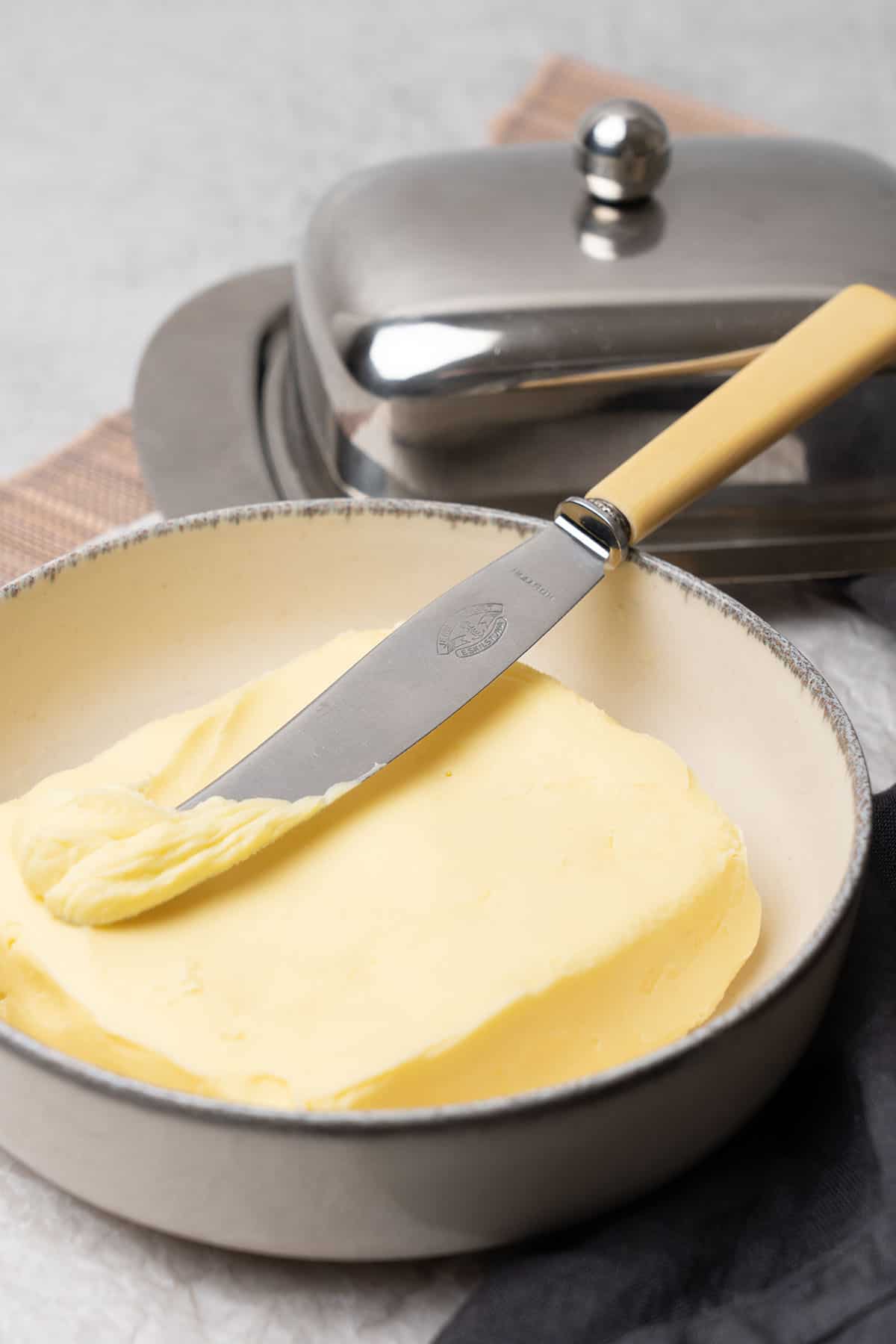
What is homemade butter made of
Ever wondered, how is butter made? Well, it's really not all that complicated and only requires one basic ingredient. A homemade butter recipe is almost always made with heavy cream, which is the milk fat that collects at the top of non-homogenized milk. Heavy cream is high in fat and consists of about 36% to 40% fat, which is more than whipping cream and half and half. This makes it ideal for making rich creamy butter at home over other milk products.
However, that being said, it is also possible to make butter at home with raw milk, which is commonly sold at health food stores and organic markets. Yet, it does take a bit longer to make because it requires you to separate the cream from the milk yourself instead of just buying heavy cream at the market.
How to make butter from cream
How to make butter at home from cream? It is actually quite an easy recipe with no prep time! And you'll be happy to know that there are several different ways to do it from using a mixer, blender, or jar to just doing it the long way by hand!
But! What is the easiest way to make butter at home? I've outlined 4 methods here for DIY butter from heavy cream and provided easy step-by-step instructions. So just pick which way works best for how to make butter from heavy cream for you and it's sure to turn out perfectly!
How much cream do you need to make butter? If using 36% cream and want to make 82% butter simply start with about x 2.5 cream. So, if want 240 g butter, start with 600 g cream. In cups, if want 1 cup of butter, start with 2.5 cups of cream.
Before you give any of the methods a try, it's important to know that heavy cream will go through 4 different stages as the butter is being made:
- Frothy: When you first start mixing it will look frothy.
- Whipped cream: After a few minutes it will turn into fluffy whipped cream.
- Broken: Have you ever over- whipped heavy cream - hoping that it will get stiffer - to the point that the cream breaks? This stage might be too late for whipped cream, but keep going and you can make butter at home
- Solid: At the very end it will become solid and with white liquid.
1. Make butter in a jar
This is a simple way of making butter at home. It's not just easy to do, but quite fun and a good workout too!
How to make butter in a jar? All you'll need, aside from the heavy cream, is a small mason jar with a tight fitting lid.
- Pour the heavy cream into a clean jar and screw the lid on tightly.
- Start shaking the jar vigorously and continuously without stopping for 5 minutes. You will probably need to switch hands or get someone else to take a turn, but it's important that you agitate the cream nonstop.
- As you shake the cream it will first become whipped cream before it really begins to thicken. But when you start to hear sloshing in the jar you're almost done. Just give it a few more good shakes and the butter should be churned.
- Remove the churned cream from the jar and put it in a fine mesh sieve over a bowl. You'll need to scrape the jar to get all of it out. What's left in the sieve is your butter and the leftover liquid in the bowl is buttermilk, which can be saved and used in buttermilk lemon blueberry muffins or pancakes!
- Using your hands, squeeze the freshly made butter over the sieve to remove as much of the buttermilk as possible while at the same time forming the butter into a ball.
- Add some ice and water to a medium bowl to make ice water. Now, put the ball of butter into the ice-cold water to remove any residual buttermilk. If the water is really cloudy, you may need to do this step again.
- Add a pinch of salt if you like by beating it into the butter. This is an optional step. Right now you have unsalted butter perfect for baking. If you add a bit of salt then it's perfect for buttering bread.
💡Top Tip: You can use a marble to work as a mini churn to speed the process up a bit. Just put it in the jar at this time you add the cream.
2. Make butter in a mixer
Making butter with a mixer is my favorite method, you can use a stand mixer or an electric hand mixer. Yet, whichever one you choose you'll want to use a deep bowl and cover it if possible until the cream begins to thicken up a bit. Stand mixers often come with splash guards, which are ideal for making homemade butter to keep the liquid from making a mess.
- Pour the heavy cream into the bowl of your stand mixer or a deep bowl that won't chip.
- Begin whipping the cream at medium speed. If you are using a stand mixer you'll want to use the whisk attachment. Then once it starts to thicken you can turn the speed up to medium-high.
- At first, the cream will turn into whipped cream, then form stiff peaks, and then begin clinging to the beaters as the butterfat separates from the liquid. The entire process will take about 10 minutes and when done the butter will be solid with liquid on top.
- Pour the liquid off of the top of the solid butter. This liquid is buttermilk, so you can save it if you like to use it in other recipes.
- Put the solid butter in a fine mesh strainer over a bowl and begin squeezing the butter with your hands to remove the rest of the buttermilk. You can also use a rubber spatula to press it against the strainer.
- Form the strained butter into a ball. Then put it into a bowl of ice cold water to remove any leftover buttermilk. You may need to do this a few times until the water is fairly clear.
- Work the salt into the butter if you are making salted butter. Or, leave it unsalted and ready for pastry making!
💡Top Tip: If you don't have a fine mesh strainer, you can also use cheesecloth to squeeze the buttermilk out of the butter.
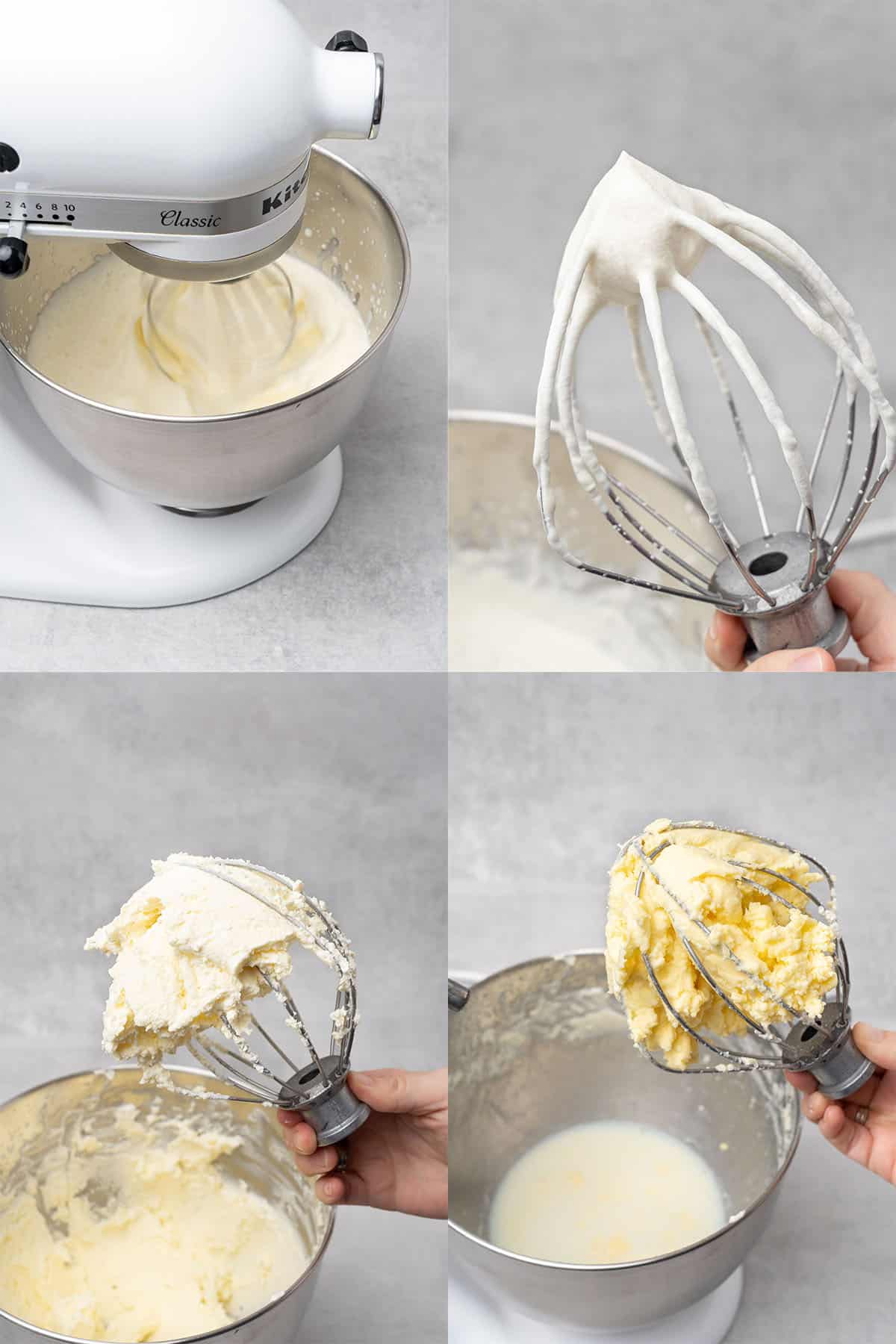
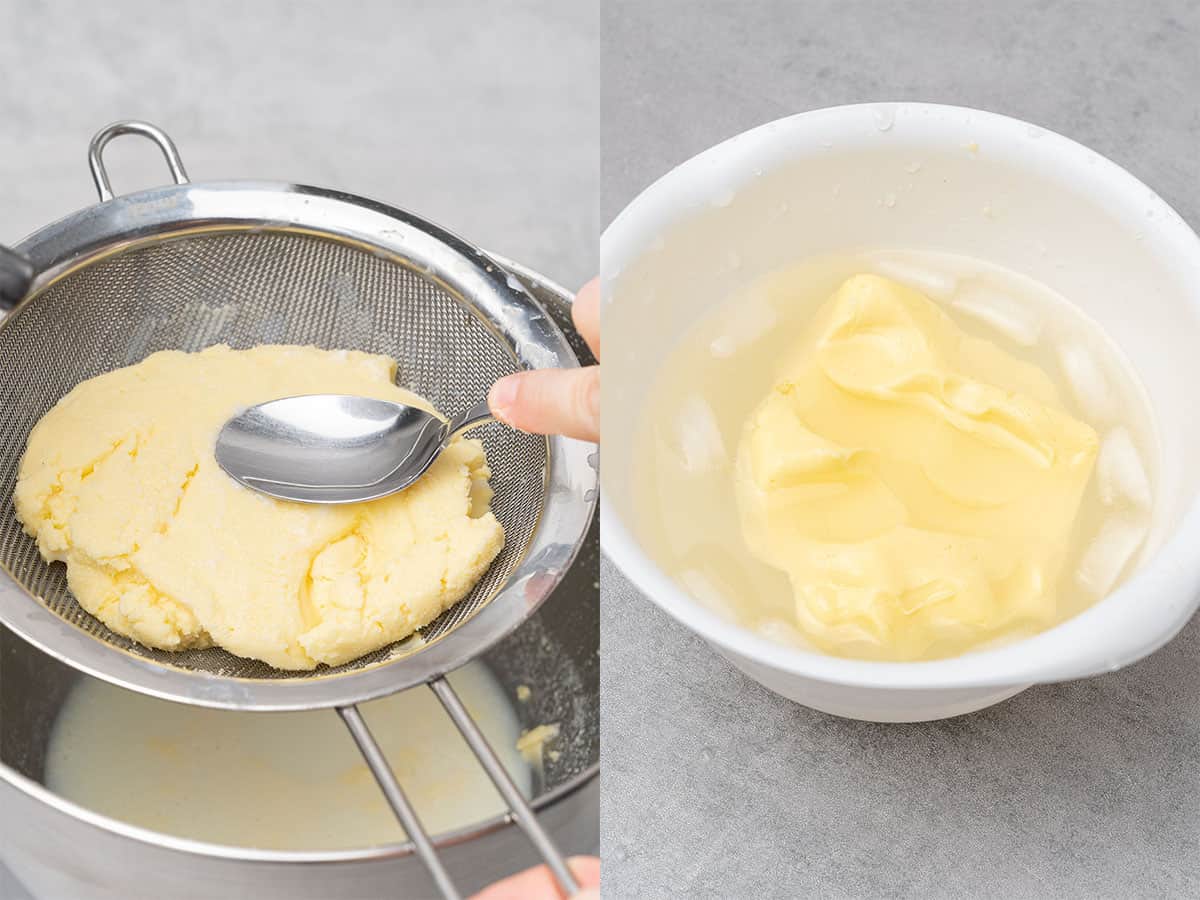
3. Make butter by blender
How to make butter in a blender is very similar to how to make butter at home with a mixer. You're basically just using a different piece of equipment. So if you don't have a mixer and don't feel like shaking the cream in a jar, this method may be a good option for you!
- Put the heavy cream into the pitcher of your blender and then secure the top.
- Start blending the cream on high for about 5 to 7 minutes. But during this time you'll need to stop the blender from time to time and scrap the sides down.
- Once the cream has turned into butter, remove the lid and pour the buttermilk on top into a medium bowl.
- Remove the solid butter from the blender and put it in a fine mesh strainer over the bowl with the buttermilk. Then start squeezing the butter with your hands to remove as much of the remaining buttermilk as possible.
- Turn the butter into a ball using your hands and then remove any leftover buttermilk by rolling it around in a bowl of ice water. The butter is done being washed once the water is fairly clear, so you may need to change the water a few times.
- Blend in about ½ teaspoon salt for salted butter or you can leave the butter unsalted and perfect for cooking.
💡Top Tip: This blender butter-making method can also be done using a food processor if you don't have a blender.
4. Make butter by hand
Now, how do you make butter by hand? If you really want to make butter at home with no tricks or special equipment you can do it by hand using just a whisk! It takes some elbow grease and it is quite a workout, but the results are both tasty and rewarding.
- Pour the heavy cream into a large deep bowl.
- Start whisking the cream and just keep going through all the stages of transforming it into butter from getting frothy, then turning it into whipped cream, and finally becoming solid. This can take a long time to do and how long it takes depends on how vigorously you whisk.
- Transfer the solid butter to a fine mesh strainer placed over a bowl to drain the liquid. Now, start squeezing the butter with your hands to remove the rest of the liquid. This liquid is actually buttermilk so feel free to save it if you like.
- Mold the butter into a ball and put it into a bowl of ice water. This is done to wash off any leftover buttermilk. You will need to repeat this washing process until the water is fairly clear.
- If you are making salted butter, now is when you will blend it into the butter.
💡Top Tip: Use a sturdy wire whisk that won't bend or break as the butter begins to become solid.
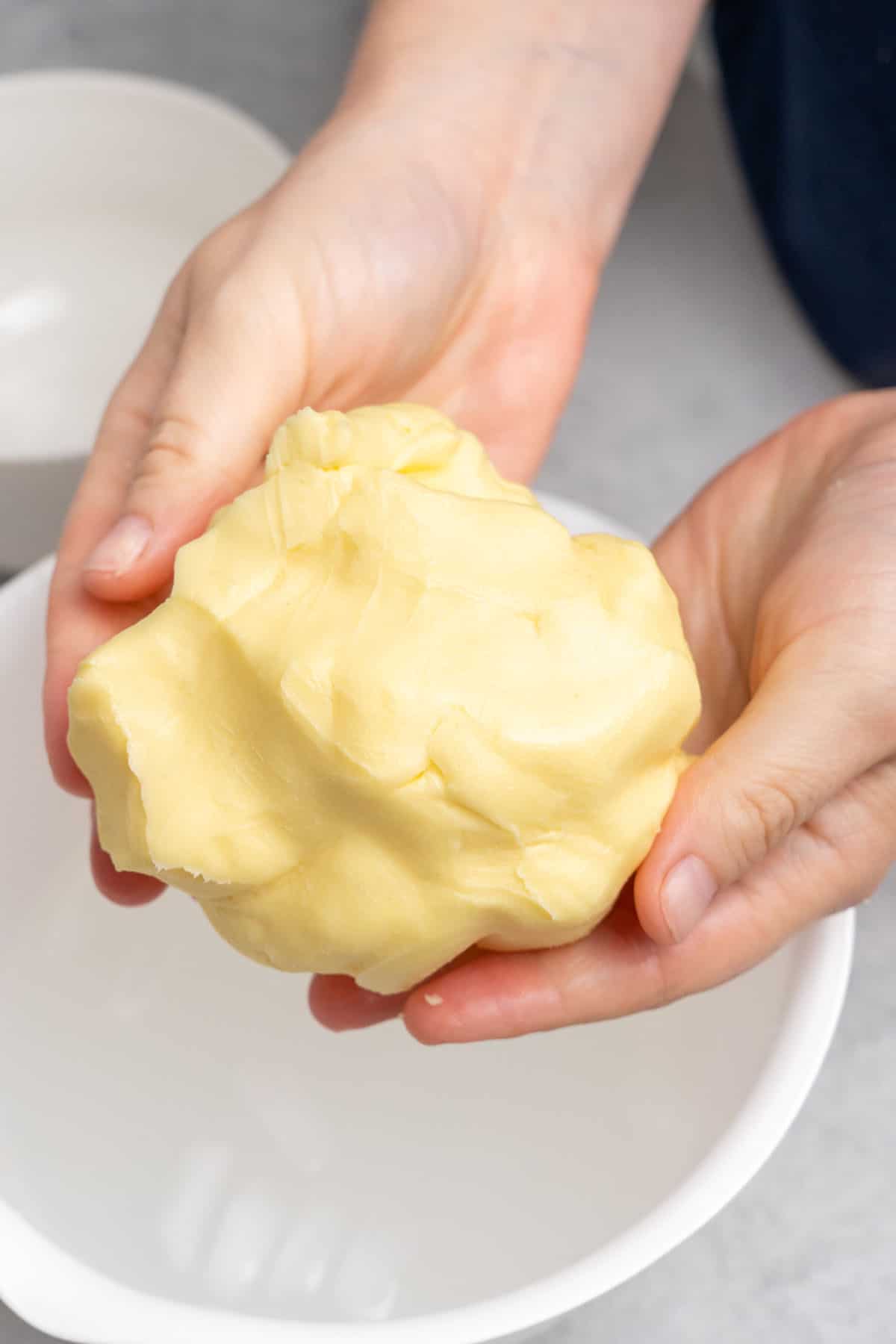
How to make butter from milk (without heavy cream)
Ever wondered how to make butter from milk at home? As we have covered, butter is almost always made from heavy cream, but how to make butter without heavy cream? Well, heavy cream comes from milk so it is possible to make butter starting with milk.
However, making butter from milk at home is only possible using raw milk and you need to first separate the cream from the milk. Once that's done, the process of how to make butter from raw milk is the exact same as using heavy cream.
- Put the raw milk in a clear jar or jug. This will make it easier to see the cream line that is going to form. Now, put the raw milk in the refrigerator for a day to give the cream time to rise to the top.
- Once the cream has had time to rise to the top, use a large spoon to remove it and put it in a container. You can also use a turkey baster to take the cream off the top.
- Let the separated cream sit out at room temperature for about 2 hours to warm up a bit.
- Now use the separated cream to make butter using the jar, mixer, blender, or by hand method.
💡Top Tip: Be sure not to mix the milk with the cream as you skim it off the top. It can lead to butter that doesn't come together as easily and also butter that goes bad faster.
How to store butter
First, you should know that homemade butter will not keep like store-bought butter. It's not as shelf-stable and can go bad much faster. This can happen even sooner if the buttermilk is not fully removed when making and washing the butter.
But if you do a good job of removing the buttermilk from the butter and store it in an airtight container, this easy homemade butter will keep at room temperature for about 2 days but I recommend refrigerating it for about 3 weeks.
It can also be stored in the freezer for many months. Just roll the butter into a log shape and then wrap it well in plastic wrap before freezing.

Expert tips for making butter at home
- For the best flavor and creamiest butter use a high quality heavy cream.
- Use heavy cream, not heavy whipping cream. Heavy cream has a slightly higher fat content that is needed to make the butter solidify better.
- You must use raw milk to make butter from milk. Regular milk will not work as there is no cream to separate from the milk.
- Put a clean marble in the jar to work as a mini churn to speed up the process when making butter in a jar.
- Squeeze out as much buttermilk as you possibly can once the butter is solid. You can also press the butter against the side of a fine mesh sieve with a rubber spatula.
- Keep washing the butter off in the cold ice water until the water is almost clear. This is how you know that the buttermilk has been completely removed.
- The water must be ice cold to wash the butter or it will melt the butter.
- Divide the butter up into portions and freeze it, so that it keeps longer and doesn't spoil.
- A rubber spatula is a great tool to use when making butter. It scrapes it from bowls to storage with ease leaving little to no butter behind to waste.
- You can save the leftover buttermilk and use it in other recipes.
Homemade butter - Flavoring tips
How to make butter at home flavored? To begin, when you flavor butter it's called compound butter and there are many different flavor combinations that you can create that take already delicious plain butter to a whole new level. They can be savory or sweet and used to spread on bread, butter pancakes, or cook with! Just imagine homemade garlic butter! Yum!
It's a really easy process to flavor butter. Basically, all you do is take room-temperature butter and mix it together with flavoring ingredients in a bowl using a rubber spatula. You can also mix the butter together with the ingredients using a mixer for ease. Then put the flavored butter onto a piece of parchment paper and roll it up into a log. Now, twist the ends of the parchment paper and place the butter log into the fridge for a few hours to firm up.
It's also important to note that most flavored butter is made with salted butter, so keep that in mind when choosing your flavors. These are just a few of the most popular flavors of compound butter.
- Fresh Rosemary
- Lemon and Fresh Chives
- Mixed Herb and Garlic
- Roasted Garlic
- Stone Ground Mustard
- Cajun Seasoning Spiced
- Fresh Dill
- Lemon and Black Pepper
- Red Wine with Black Pepper and Rosemary
- Honey
- Pumpkin Spice and Vanilla
- Maple Syrup and Cinnamon
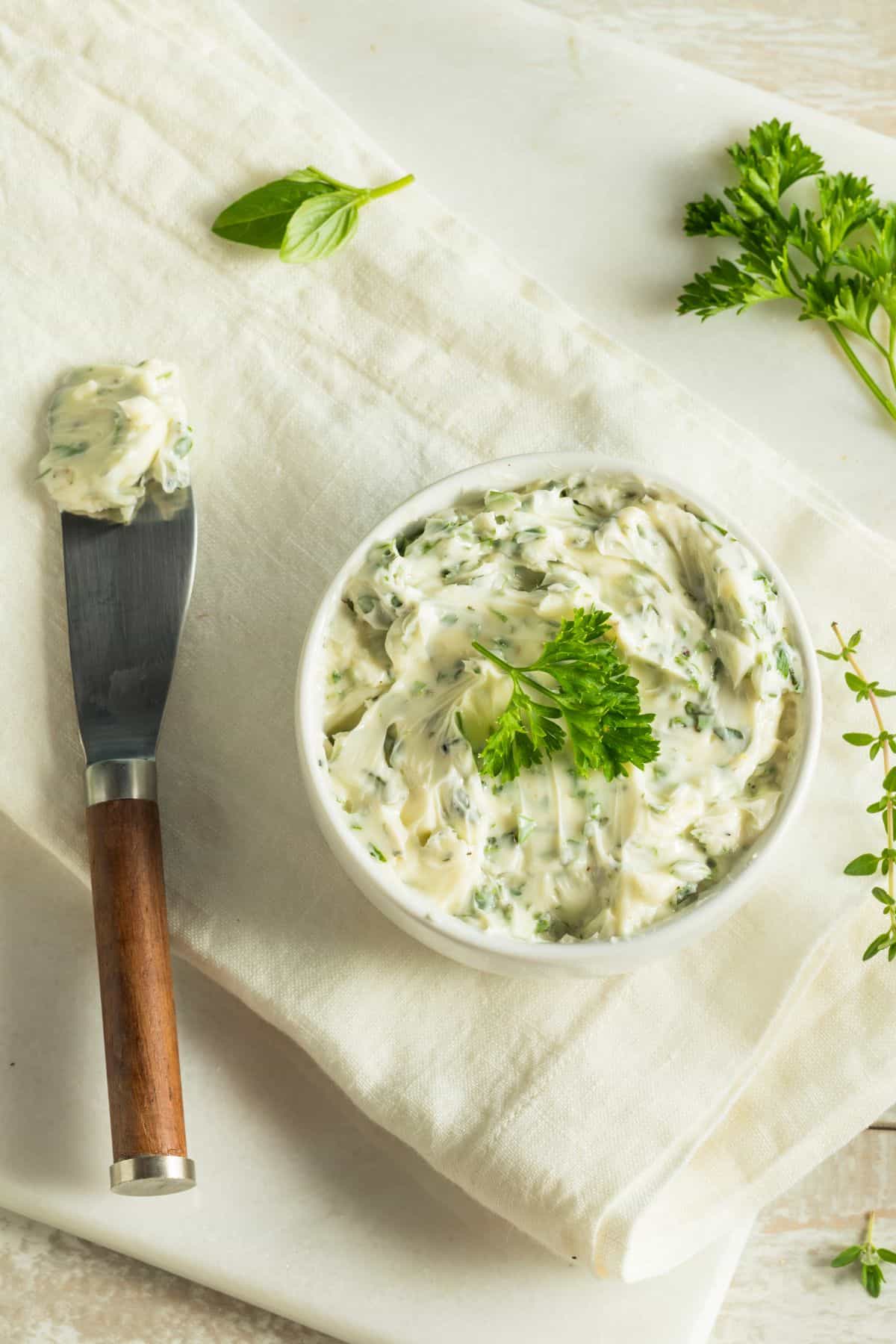
Homemade Butter Recipe FAQS
Yes, once the butter is made (in a mixer, in a jar, or in a food processor, choose your preference), simply just roll it to form sticks. Then wrap them in plastic wrap and store them in the fridge or freezer.
Not really because heavy cream and raw milk are on the expensive side. But homemade butter is so good and worth it from time to time.
Yes! If you want to make quick homemade butter for baking just don't add any salt at the end and it's perfect for both baking and cooking.
When this happens it means you didn't squeeze out enough of the buttermilk from the solid butter.
You always add the salt to the butter at the end. However, this is optional and unsalted butter is what you need in baking recipes.
Butter milk is, in fact, the by-product of homemade butter! Start whipping heavy cream, at first the cream will turn into whipped cream, then form stiff peaks, and then begin clinging to the beaters as the butterfat separates from the liquid. The liquid itself is butter milk!
It is possible to keep DIY butter out at room temperature for a couple of days before it spoils. Yet, I recommend just putting it in the fridge to be on the safe side.
Homemade butter that is stored properly in an airtight container will keep in the fridge for up to 3 weeks.
Yes! You can store butter in the freezer for 3 to 4 months and it's a fantastic way to have it on hand. Just mold the butter into a log shape. Then wrap it in several layers of plastic and put it in the freezer.
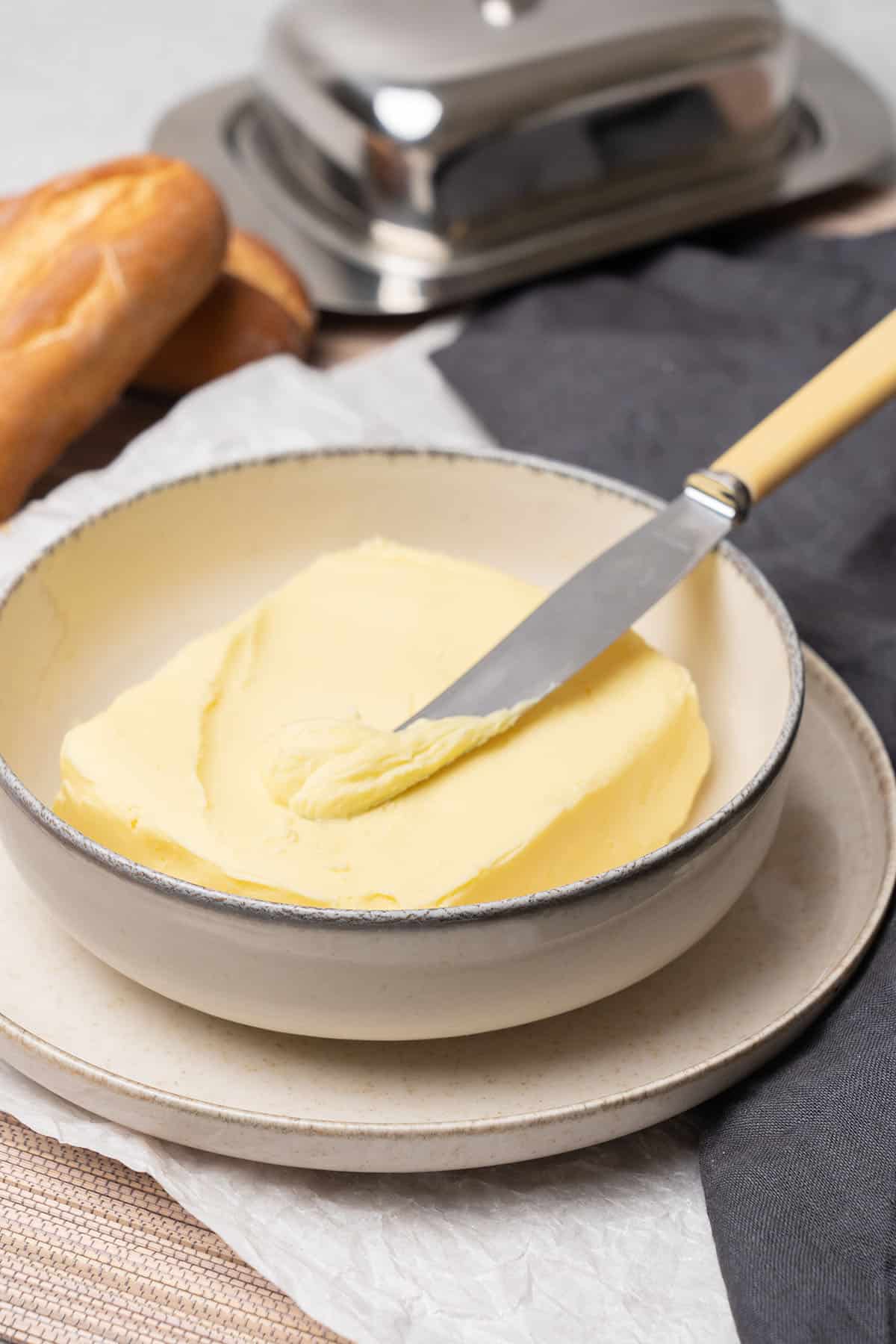
Conclusions
So as you can see, making butter at home can be done very easily and successfully in a variety of ways. All you need is some heavy cream or raw milk and then select the butter-making method that works for you. You could even try different methods to discover which one you like best!
But whether you choose to make homemade butter in a jar, with a mixer or blender, or even by hand with a whisk, all the methods work wonderfully and produce rich and creamy butter. The most important thing when making butter is to do your best to remove as much of the liquid as possible from the butter. Doing this will produce the best results and is a simple step that only takes an extra minute.
You can also choose to add salt to the DIY butter or not. It's totally up to you. But keep in mind that if you want to use butter for baking, unsalted butter is what you will need. Yet, if you want to use it to butter bread or potatoes, go for the added salt.
So while making your own homemade butter from scratch may seem fancy at first, this article has actually shown you how to make butter easy peasy style!
My favorite baking recipes made with delicious butter
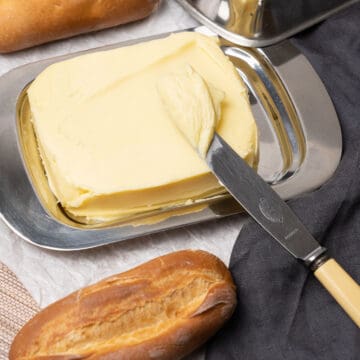
How to make butter at home
Equipment
Ingredients
- 600 g (2½ cups) Heavy cream use min 36% fat content cold heavy cream
US customary cup measurement is an indicative figure only. Measure the ingredients with a digital scale by weight (gram). Baking is art but also science which requires precision and accuracy.
Instructions
- The DYI butter making process is exactly the same whether you are using a jar, hand wisk, electric hand mixer or stand mixer. 600g cream will make about 240g butter. In cups, 2.5 cups cream will make about 1 cup of butter.
- Pour cold heavy cream into the bowl of your mixer.
- Begin whipping the cream at medium speed using the whisk attachment. Once it starts to thicken, turn the speed up to medium-high.
- The cream will go through the following stages: 1. it will turn into whipped cream, then 2. stiff peaks form, and then 3. begin clinging to the beaters as the butterfat separates from the liquid. Then, 4. the butter will be solid with liquid on top.
- Pour the liquid (butter milk) off of the top of the solid butter and put the solid butter in a fine mesh strainer over a bowl and begin squeezing the butter with your hands to remove the rest of the buttermilk.
- Place the butter into a bowl of ice cold water to remove any leftover buttermilk. You may need to do this a few times until the water is fairly clear.
- Work the salt into the butter if you are making salted butter. Or, leave it unsalted and ready for pastry making!
- For the best taste and consistecy, store the butter refrigerated up to 3 weeks.
Notes
- For the best flavor and creamiest butter use a high-quality heavy cream with at least 36% fat
- Use heavy cream, not heavy whipping cream. Heavy cream has a slightly higher fat content that is needed to make the butter solidify better
- Squeeze out as much buttermilk as you possibly can once the butter is solid. You can also press the butter against the side of a fine mesh sieve with a rubber spatula.
- Keep washing the butter off in the cold ice water until the water is almost clear. This is how you know that the buttermilk has been completely removed.
- The water must be ice cold to wash the butter or it will melt the butter.








thomas
This is very thorough, answers most questions, but i have one,
what happensin to the butter if you put in the salt or rosemary just before it starts to separate? As i have done that, i don't think it changed much,
Balint Balazzs
Well the butter might gets flavored a bit with the rosemary and salt but in general, flavorings are put into after the butter is formed.
JOHNNIE L THOMAS
AWESOME RECIPE ! THANKS!
Barbara
I have the silverware that is seen in this recipe.
Katalin Nagy
Oh how fun!
Norma Williams
This is something I’m going to definitely try. It easy and will probably taste better than what we buy in the store. Thanks for sharing.
Kata
it tastes amazing and so easy to incorporate salt or your favorite herbs into it to make it taste fancy:)